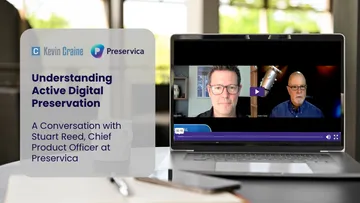Understanding Active Digital Preservation™ - A Conversation with Stuart Reed, Chief Product Officer at Preservica

Organizations of every size and type depend on data and information to operate. Ensuring that this digital content remains accessible, secure, and usable over time is crucial for maintaining compliance, efficiency, and business continuity.
In a conversation with Stuart Reed, Chief Product Officer at Preservica, we explore the growing field of Active Digital Preservation™, which goes beyond traditional archiving to ensure long-term accessibility, usability, and authenticity of digital records, and how tools like Preservica’s Preserve 365 are addressing the issues. You can see the complete video interview here.
What is Active Digital Preservation™?
Most organizations keep data backups and many have document management systems. Active Digital Preservation goes a step further by automating the preservation of important digital content so that it remains accessible and useful over time.
"Active Digital Preservation™ automates the principles of preservation, reducing risk and administrative burden while keeping a true record of content safe, whether it’s for a decade or for generations to come,” Stuart explains. “Files created in today’s formats—such as PDFs, JPEGs, or even old WordPerfect documents—may not be accessible in the future without proper preservation strategies. This ensures that digital content is usable even if the original formats become obsolete.”
“Active Digital Preservation™ ensures that digital content is usable even if the original formats become obsolete.” |
The Challenges of Long-Term Digital Content
Stuart points out that the biggest challenge organizations face when it comes to long-term digital preservation is the shelf life of digital content. “We’re talking about content that is valuable to an organization, either for commercial heritage reasons or compliance purposes,” says Stuart. “This long-term content often needs to be stored for seven years or more, depending on regulations or organizational policies. Without Active Digital Preservation™, organizations risk losing access to this content or finding that it has become corrupted or unusable due to file format obsolescence.”
Why Isn’t “Normal” Archiving Enough?
There is a common misconception that traditional archiving solutions are sufficient for long-term preservation. But the approach comes with significant limitations.
“There’s no point in dumping all your important digital content into a generic archive or file server without the means to use it or prove that the document is authentic and trustworthy,” says Stuart. Archiving without active preservation increases the risk of losing valuable information. If, for example, an organization archives emails with attachments, the attachment could be lost or become unreadable without preserving the context and structure of the original data. Active preservation not only keeps multiple parts of digital content together but also ensures it remains readable and traceable to its original form. This is particularly crucial for compliance purposes, where proving authenticity is essential.
Enter Preserve 365: Augmenting Microsoft’s Capabilities
Preservica recently launched Preserve 365, a tool that integrates directly with Microsoft 365 to address the need for seamless and Active Digital Preservation™. This innovative solution enables organizations to easily manage, protect, and access long-term digital records within their existing Microsoft environment, reducing manual processes while ensuring compliance, data integrity, and future accessibility across a wide range of file formats.
MS365 has excellent tools for document management and collaboration, but it wasn’t designed with long-term digital preservation in mind. |
Stuart points out that, while MS365 provides excellent tools for document management and collaboration, it wasn’t designed with long-term digital preservation in mind.
“Preserve 365 is augmenting and driving additional value from your existing Microsoft 365 investments. It allows you to fully automate the transfer of important records into an archive while maintaining their authenticity and usability.”
One of the key advantages of Preserve 365 is its ability to automate the archiving process and ensure documents remain usable, even if their original formats become outdated. “This tool minimizes the risks of manual errors, data corruption, and compliance breaches,” says Stuart. “It streamlines the process of preserving and retrieving records from within the familiar Microsoft environment.”
Typical users of Preserve 365 include government departments handling court records, land and infrastructure data, and historical documents, as well as corporate environments where market data, contracts, and special project information need to be preserved.
Transitioning from Traditional Archiving to Active Digital Preservation™
Stuart offers practical advice for organizations looking to transition to Active Digital Preservation™. “You don’t have to do everything at once. The flexibility of Preserve 365 allows you to apply it to one SharePoint site or across multiple instances of Microsoft 365, making it easier to integrate into your current workflow.”
Ensuring that important digital content remains accessible, secure, and usable over time is crucial for maintaining compliance, efficiency, and business continuity. Watch the entire video interview with Stuart Reed and learn more.




